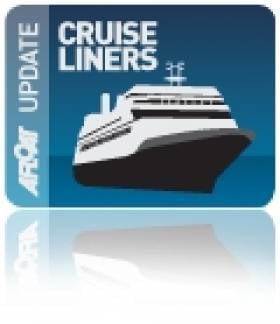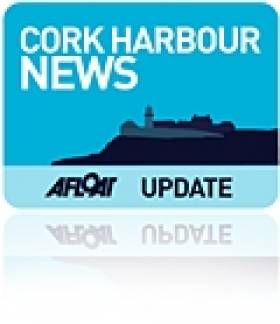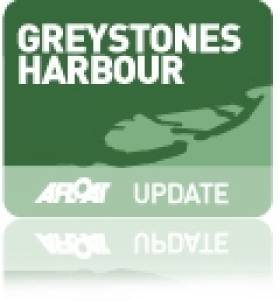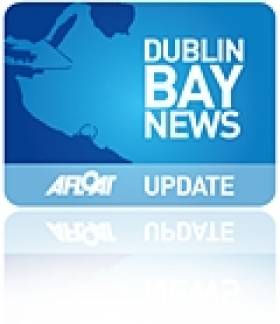Displaying items by tag: Harbour
Free Ferry for Cork Harbour Open Day
Dun Laoghaire Yacht Clubs Voice Concern Over Plan
Dun Laoghaire Yacht Clubs are voicing concerns about the impact on sailing if a 'cruise ship jetty' is constructed as part of the recently published harbour masterplan.
Dublin Bay Sailing Club, Dun Laoghaire Motor Yacht Club, National Yacht Club, Royal Alfred Yacht Club
Royal Irish Yacht Club and Royal St George Yacht Club. are also concerned about access to the water if a proposed 'pedestrian walkway' in front of the waterfront clubs was completed.
The clubs have engaged 'professional help' to prepare a submission to outine the concerns.
Also seen as a problem is the 'lack of sufficient facilities in the masterplan for hosting significant international sailing events'.
A survey in 2009 by the Irish Marine Federation (IMF) calculated a €3million spend by participants connected with the 500-boat Volvo Dun Laoghaire regatta. The clubs have previously stated they see the harbour's future as a leisure facility.
A masterplan model was on display by the Harbour Company in the month of August.
Writing to members in the current edition of the National Yacht Club's newsletter commodore Paul Barrington says the clubs 'hope to further engage with the harbour [company] to find a mutually acceptable way forward'.
Water Rat: Harbour Plan is a Curate's Egg
Queen Elizabeth Arrives on Dublin Bay
Port of Cork to Mark Maiden Arrival of MV Queen Elizabeth
On Saturday 10th September 2011, MV Queen Elizabeth will make her maiden call to Cobh in the Port of Cork. To coincide with this visit the Port of Cork will formally present a plaque to the Captain of the Queen Elizabeth on the quayside at 10.30am.
This will be followed by a Lusitania Memorial Service led by the Captain and Chairman of the Port of Cork at the memorial in Cobh Town.
Saturday 10th September 2011
0900hrs - MV Queen Elizabeth arrives in Cobh
1045hrs – Plaque exchange with Port of Cork and Cunard
1115hrs – Lusitania Memorial Service Begins in the centre of Cobh Town
1145hrs – Memorial Service Ends
1145hrs – 1245hrs – Band 1 Southern Brigade will play in the promenade in Cobh
Third Cork Harbour Open Day Set for this Weekend
This year Cork Harbour Open Day is set to be a great day with so much happening all around the harbour. Now in its third year, Cork Harbour Open Day has grown and each year offers more and more activities both on and off the water.
The day itself is a great day for people to see exactly what Cork Harbour has to offer, and this year is no exception with the second largest natural harbour in the world will playing host to the Cobh to Blackrock sailing race, kayaking on the River Lee, crab fishing in Cobh, and for the first time a free open day at the National Maritime College of Ireland (NMCI) in Ringaskiddy and Fastnet Lines MV Julia open to the public for tours and lunch.
Cork Harbour Community Radio will broadcast throughout the day on frequency 98.3FM live from the NMCI. This community radio initiative is part of a response to the great sense of community developing in the Cork Harbour area and has been made possible by the combined effort and support of many harbour side groups and organisations.
This year will also see the first ferry shuttle service operated by 'Whale of a Time' and sponsored by the Port of Cork and NMCI running in the lower harbour calling at Ringaskiddy, Monkstown, Cobh, Aghada and Crosshaven. Free to anyone who wishes to use it, this ferry will be a great way to see the harbour and get around to the different locations and attractions.
Visitors to Ringaksiddy will be given the opportunity to go on a free guided tour around the National Maritime College of Ireland and see their panoramic bridge ship simulators, the survival pool and the marine workshops. Staying in Ringaksiddy, at the Deepwater Quay, Fastnet Lines' MV Julia will open to the public giving people the chance to go onboard the ferry and even have some lunch if they wish. In the evening, Cork Corona Film Festival will hold a fundraiser themed the 'Amazing Cork Maritime Experience' at the NMCI from 5pm onwards.
In Cobh, Cunard's MV Queen Elizabeth will make her maiden call to the Port of Cork and to coincide with this visit, Cunard and the Port of Cork have organised a Lusitania Memorial Service in Cobh led by the Captain of Queen Elizabeth. To add to the occasion, Band 1 Southern Brigade will play in the promenade after the service. Both events are free and open to all.
In the afternoon 'See You in Cobh' will run a crab fishing competition for kids. The Irish Coastguard, RNLI and the Search and Rescue Helicopter will perform a search and rescue demonstration in the lower harbour near Monsktown and Ringaskiddy at 3pm. At 5pm when MV Queen Elizabeth departs a 'Fond Farewell' is being organised to encourage spectators around the harbour to wave this great ocean liner off as she departs Cork harbour. Great locations around the harbour to see the departure are Roches Point, Weavers Point, Camden Fort, Cobh town or Whitegate.
Spike Island will be open to the public all day, with boat rides operating from Kennedy Pier in Cobh to the island throughout the day. Live music, face painters, clowns and jugglers will be on the island to entertain and visitors to the island are being encouraged to bring their own picnic for the day.
In Crosshaven, the Rescue Camden Committee have organised a free open day from 12-6pm. The fort will host the Airborne 101 re-enactors and a weapons display and a 'Port in Pictures' photograph exhibition. Camden Fort is a perfect location to watch MV Queen Elizabeth as she departs Cobh at 5pm. Crosshaven will also hold their annual triathlon at 4pm.
In Cork City, the Irish naval vessel L.E.Ciara will be open to the public for free tours of the ship from 11am to 4pm. Also in the morning visitors will get to see the amazing 150 cars taking part in this year's Cannonball Run in aid of Barretstown Kids charity, as they depart Custom House quay at 11am. Blackrock Castle Observatory will present their theatrical tours bringing the colourful story of the castle to life from 400 years ago to present day. A great venue for all the family and a super location to watch the Cobh to Blackrock sailing race, as the yachts head up the river.
In Aghada, there will be tales and stories of the south east side of the harbour throughout the day held in Rosies Bar. Visitors can use the ferry shuttle which would take them to Aghada's new pontoon facility recently opened.
Aimed at embracing what Cork Harbour has to offer, the Cork Harbour Open Day aims to raise awareness of the different activities available for people in the harbour both on and off the water. It's a great day for all the family with many events free to everyone.
The idea for a Harbour Open Day emerged from discussions between various stakeholders involved in the development and implementation of the Integrated Strategy for the Harbour. A group comprising representatives from UCC, City and County Councils and the Port of Cork set about working together to engage users of the Harbour and to organise the Open Day.
Avoiding a Capsize to Windward
We had great reaction to the dramatic 'windward capsize' picture from last weekend's Feva national championships on our home page.
Afloat Photographer Bob Bateman (who else?) was on the Curlane Bank in Cork Harbour to capture the windward capsize of plucky youngsters Grattan Roberts /James McCarthy who finished eighth in the 30-boat regatta. Here's the full sequence of that windward capsize...
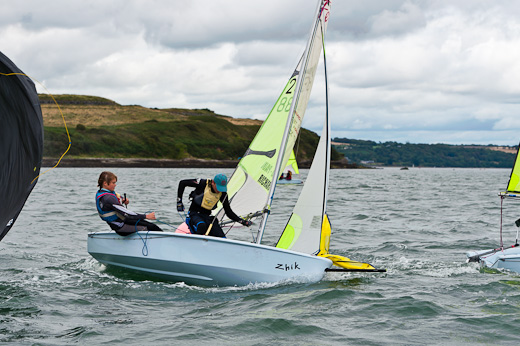
Approaching the weather mark. The helmsman bears off for the important rounding and the crew moves inboard for the spinnaker hoist...
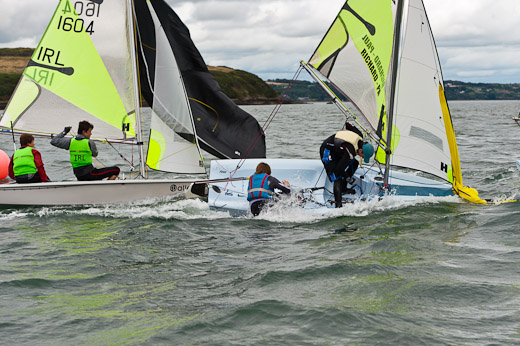

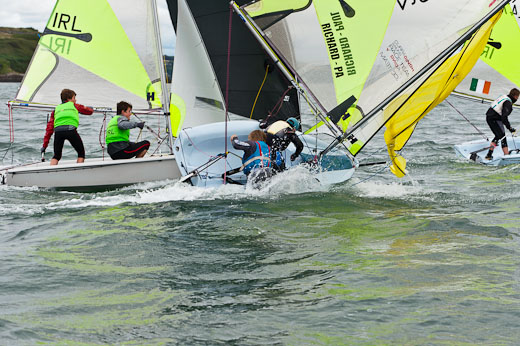
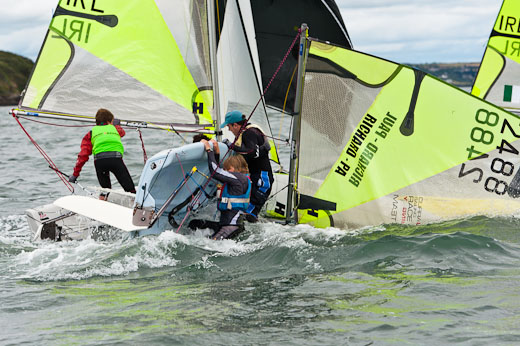

To avoid this, it's an idea to ease off the kicker to a marked position so as to keep the leech closed.
It's worth remembering too that in big breezes you need to ease and gently bear away with correct twist in the main to stop a capsize to leeward!
Centreboard position also plays a part. Too little centreboard down can result in a broach to weather whereas too much centreboard down in a bear away can result in capsize to leeward.
Dun Laoghaire Plan is a Curate's Egg
When a property doesn't have as many redeeming features as the developer would like, extra effort is put into talking it up by way of the promotional brochure. It could be said that the gloss of the brochure takes the place of the gloss of the property. It is to be earnestly hoped that this isn't the case with the Dun Laoghaire Harbour Company's Consultation Masterplan. While a fine example of the graphic designer's craft, once the observer has penetrated the overly complex web presentation, the content is closer to the curate's egg – a mixture of good and, well, not so good.
The introduction to the plan does a fine job of setting the context, although the author loses some of the high ground by suggesting that Dun Laoghaire is "one of the most beautiful man-made harbours in the world".
The masterplan does recover from this and the other floral verbosity of the opening statements to identify the crucial roles played by marine leisure interests and the town of Dun Laoghaire in the sustainable development of the harbour. The plan regularly refers to the need for careful design to promote greater interaction between town and harbour, an area of failure of past administrations on both sides of the railway tracks.
In the detail, it is interesting to note that the plan shies away somewhat from the flawed concept, mooted in previous versions, that Dun Laoghaire can become a cruise liner port. This is clearly a non-runner in the short to medium term as there is very little to commend Dun Laoghaire over its larger, deeper and more commercially inclined foster parent to the north.
Another area that seems to be set up for failure is the idea that the Harbour Company, in their own words "custodians of this valuable national asset", could contemplate the private ownership of areas of the harbour through property development.
The plan hints at improved access for the watersports constituency, but a serious flaw is the lack of a stronger stance on establishing a safe, wide, non-tidally restricted slipway with easy access to open water, something that does not exist in greater Dublin area outside of the yacht clubs. Such a facility, with the appropriate management, could be self funding.
And in the pie-in-the-sky category is the suggestion of placing a public baths on the inside of the East Pier, a proposal that requires the reclamation of valuable sheltered water.
The plan refers extensively to the diaspora project, but outside of the masterplan itself, this idea has not caught the imagination. It does refer to a maritime element in the project, but does not see this as mainstream. This is a pity, because moving the National Maritime Museum 100 metres from its current location could provide Dun Laoghaire with the iconic attraction it needs to start making it a destination in its own right, changing from its traditional role as a bi-directional gateway. A museum project on the Carlisle Pier, with the potential for floating exhibits alongside, could bring in excess of 1/4 million visitors each year.
The plan refers to similar developments in Leith, near Edinburgh, where former royal yacht Britannia is moored, but curiously neglects to mention Falmouth, where a town of some 22,000 people attracts a similar number to its recently constructed maritime museum. And neither Leith nor Falmouth enjoy the considerable transport network, both marine and land based, that makes Dun Laoghaire so easy to get to.
Comment on this story below
The 'best public boat launching facilities in Ireland' will be provided in a final Greystones Harbour Plan released today, according to Fine Gael Concillor Derek Mitchell.
Having consulted with the community Sispar has produced their final plan for the Harbour for September and are currently implementing it, the Councillor says.
'This provides the best public boat launching facilities in Ireland even in this temporary solution. There is also good walking access to the area and South Pier together with car parking and green areas. To construct the Health Centre safely the hoardings at the North end will remain but the large green area there should open in a year, Mitchell, a winner in the Ruffian class in last week's VDLR sailing regatta, told Afloat.ie
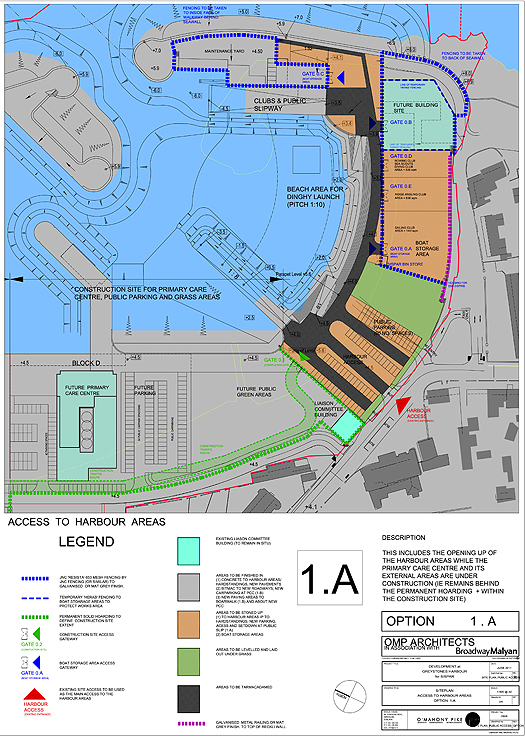
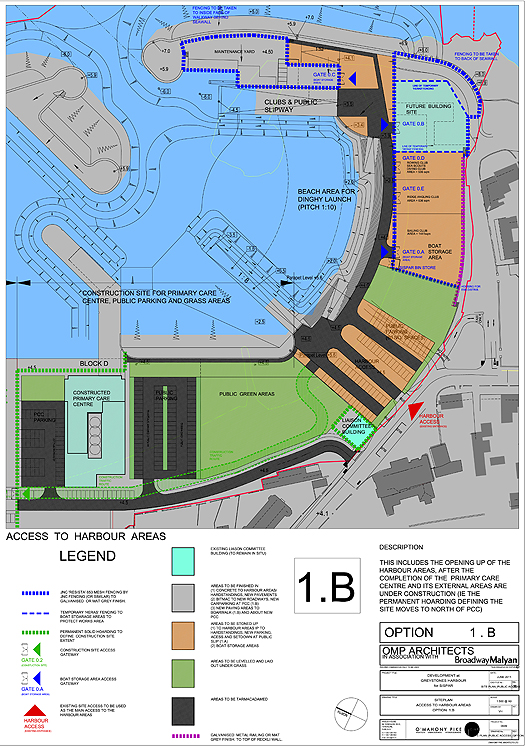
Drawings showing the proposed public access arrangements at Greystones Harbour. For higher resolution versions the pdf's are attached below.
'I am pleased they are implementing most of my plan and opposed to more meetings which will only delay implementation', he added.
Today's Irish Times editorial raises questions over the new 'masterplan' for Dun Laoghaire harbour.
As previously reported on Afloat.ie, the plan is intended to position Dun Laoghaire "as a marine, leisure and tourism destination of international calibre".
But The Irish Times says: "[The] company needs to reassure the public that all of the proposed uses can be safely accommodated within the granite enclosing arms of this great harbour, without conflicting with each other.
"Is it realistic, for example, to have greatly expanded facilities for sailing and at the same time provide berthing for very large 'next generation' cruise liners? How realistic is the plan to develop 300 apartments within the harbour area in the current market?"
Doubts are also raised about the feasibility of Dublin hosting two cruise liner facilities if plans to expand Dublin Port get the go-ahead.
The Irish Times website has more on the story HERE. The Dun Laoghaire Yacht Club's joint response to the masterplan is HERE
Councillor Derek Mitchell says Greystones Harbour will be open in early September. The news follows a meeting between developers, Sispar, and the Town Council.
According to Mitchell, Sispar told a meeting of Town Councillors that they intend to open temporary facilities at Greystones Harbour by the end of August.
This will consist of:
· Taking down most hoardings and replacing with decorative railings thus opening up the views. The railings are already being made.
· Opening the harbour beach and second public slipway which is a calmer one.
· Fencing the entire area to be given to clubs for boat parking, greatly improving facilities for Anglers, Rowers, Sea Scouts, Divers and Sailors.
· Car Parking and wide access to the new South Pier.
· Starting building the Primary Health Centre by September 2011 and completing within 12 months. This will allow part of the public square to be finished.
· Provide some moorings.
· If there is no development of homes in 18 months time they will landscape the Public Park to the North.
They will review demand for the marina and hope to put in temporary facilities at least during 2012.
These items implement most of my plan and I welcome the good news of both good facilities and starting the Health Centre this year. There will be further consultation with harbour users and residents next week. The plan will then be finalised and implemented.




























